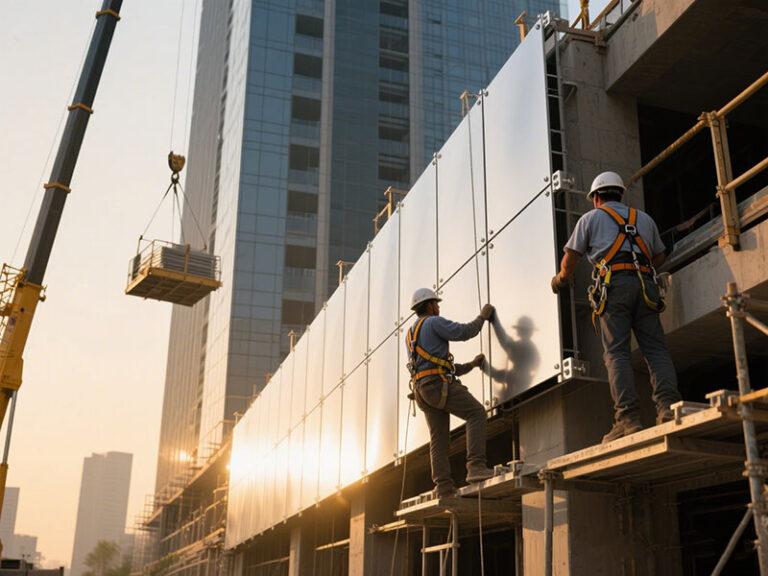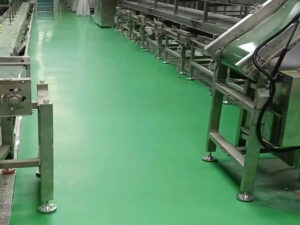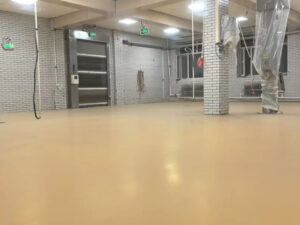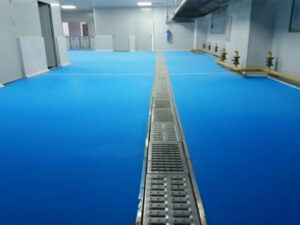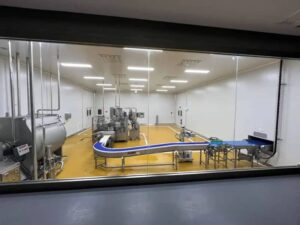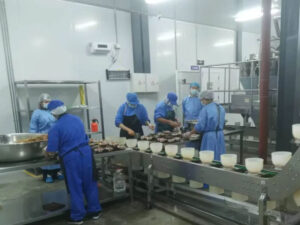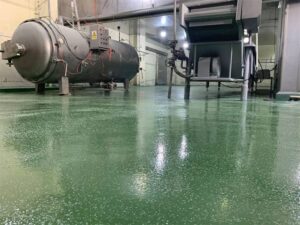1. مقدمة
تشتهر الطلاءات الفلوروكربونية (وتسمى أيضًا طلاءات البوليمر الفلوري) بمقاومتها الاستثنائية للعوامل الجوية وثباتها للأشعة فوق البنفسجية وخمولها الكيميائي، مما يجعلها مثالية للمشاريع عالية الأداء مثل الواجهات المعمارية والهياكل البحرية والمعدات الصناعية. ومع ذلك، مع توفر أنواع متعددة - مثل طلاءات PVDF، وراتنجات الفلوروكربون FEVE، والتشطيبات القائمة على PTFE - فإن اختيار النوع الخاطئ يمكن أن يؤدي إلى فشل الطلاء قبل الأوان أو إهدار التكاليف.
يغطي هذا الدليل:
- الخصائص الأساسية لطلاء الفلوروكربون وتطبيقاته
- 5 عوامل حاسمة لاختيار النوع المناسب
- مقارنة أداء طلاءات PVDF مقابل طلاءات FEVE (مع جداول البيانات)
- عملية الاختيار خطوة بخطوة والمزالق الشائعة
2. ما هو طلاء الفلوروكربون؟
طلاء الفلوروكربون هي طبقة نهائية عالية الأداء مصنوعة من البوليمرات المفلورة (على سبيل المثال، فلوريد البولي فينيلدين أو راتنج PVDF). توفر الروابط القوية بين الكربون والفلورين (C-F):
- قابلية فائقة للعوامل الجوية: يحتفظ بالألوان واللمعان لـ أكثر من 20 عاماً (مقابل 3-5 سنوات للدهانات القياسية).
- مقاومة المواد الكيميائية: يتحمل الأحماض والقلويات والمذيبات والملوثات الصناعية.
- خصائص التنظيف الذاتي: طاقة السطح المنخفضة تطرد الأوساخ، مما يقلل من الصيانة.
- المرونة الجمالية: متوفر بلمسات نهائية معدنية وغير لامعة وشديدة اللمعان.
الاستخدامات الشائعة:
- الطلاءات المعمارية: الحوائط الساترة المصنوعة من الألومنيوم والأسقف (على سبيل المثال، طلاءات PVDF للمباني مثل مطار بكين داشينغ).
- الحماية الصناعية: خزانات المواد الكيميائية، والجسور، والمنصات البحرية.
- السلع الاستهلاكية: نوافذ راقية وأثاث خارجي فاخر
3. 5 عوامل رئيسية لاختيار الطلاءات الفلوروكربونية
3.1 بيئة المشروع
| البيئة | الطلاء الموصى به | أمثلة على المنتجات |
|---|---|---|
| التعرض العالي للأشعة فوق البنفسجية | طلاء PVDF (أفضل احتفاظ بالألوان) | طلاءات AkzoNobel PVDF |
| ساحلي/عالي الرطوبة | راتنج الفلوروكربون FEVE (مقاوم للملح) | طلاءات دايكن FEVE |
| التعرض للمواد الكيميائية | PTFE أو الفلوروكربون المعدل (مقاوم للأحماض) | DuPont Teflon® industrial coatings |
3.2 توافق الركيزة 3.2 توافق الركيزة
- معدن (ألومنيوم/فولاذ): يتطلب دهان تمهيدي (مثل دهان الزنك الإيبوكسي التمهيدي).
- الخشب/المركبات: استخدم طلاء الفلوروكربون المرن لمنع التشقق.
- الخرسانة: ضع طبقة أولية فلوروكربونية مخترقة + طبقة طلاء علوية.
3.3 متطلبات المتانة
- المشاريع القياسية (10-15 سنة): الطلاءات القائمة على PVDF
- مشاريع طويلة الأجل (أكثر من 25 سنة): PVDF + الطلاءات الهجينة النانوية الخزفية
3.4 الاحتياجات الجمالية
- تأثيرات معدنية: طلاءات PVDF مع رقائق الألومنيوم.
- ألوان نابضة بالحياة: توفر طلاءات FEVE تشبعًا لونيًا أفضل.
3.5 ملاءمة البيئة والتطبيق
- خيارات المركبات العضوية المتطايرة المنخفضة: الطلاءات الفلوروكربونية ذات الأساس المائي (مثل PPG Duranar®).
- قيود المعالجة: يتطلب بعضها معالجة بدرجة حرارة عالية (180 درجة مئوية فأكثر).
4. مقارنة بين أنواع الطلاءات الفلوروكربونية
| النوع | مثال على المنتج | الإيجابيات | السلبيات | الأفضل لـ |
|---|---|---|---|---|
| PVDF | كينار 500 ®Kynar 500 | أفضل قابلية للعوامل الجوية (أكثر من 25 سنة) | خيارات ألوان محدودة | الواجهات المعمارية |
| فيف | لوميفلون® لوميفلون | نطاق ألوان واسع، معالجة محيطة | 20% أعلى تكلفة من PVDF | الهياكل الفنية |
| PTFE | تفلون® تفلون | غير لاصقة ومقاومة للمواد الكيميائية | مقاومة ضعيفة للتآكل | البطانات الصناعية |
| هجين | الفلوروكربون المعدل | فعالة من حيث التكلفة | متانة أقل (حوالي 10 سنوات) | المشاريع الملائمة للميزانية |
5. دليل الاختيار خطوة بخطوة
الخطوة 1: تقييم التعرض البيئي
- استخدم المواصفة القياسية ISO 12944 لتصنيف مستويات التآكل (على سبيل المثال، C4 عالية التآكل تتطلب FEVE أو PVDF).
الخطوة 2: تحضير الركيزة
- تحتاج الأسطح المعدنية إلى سفع رملي من الدرجة Sa2.5 (ISO 8501-1).
الخطوة 3: تحديد أولويات احتياجات الأداء
- مثال: يجب أن يعطي مشروع فندق على شاطئ البحر الأولوية لمقاومة الملح > اللون > التكلفة.
الخطوة 4: التحقق من صحة العلامات التجارية والاختبار
- الطلب:
- تقارير اختبارات الطرف الثالث (على سبيل المثال، اختبارات احتباس اللون ASTM D2244).
- دراسات حالة من مناخات مماثلة.
الخطوة 5: اختبار العينات
- إجراء اختبارات التجوية المعجّلة ل QUV (أكثر من 1,000 ساعة).
6. الأخطاء الشائعة التي يجب تجنبها
- الخطأ 1: تخطي الطلاء التمهيدي ← تفريغ الطلاء.
إصلاح: استخدم طلاء علوي فلوروكربوني + طلاء أولي متوافق (مثل الزنك الإيبوكسي). - الخطأ 2: التطبيق في درجات الحرارة الباردة بدون تعديلات → التشقق.
إصلاح: اختر الطلاءات الفلوروكربونية منخفضة المعالجة بالحرارة المنخفضة (مثل طلاءات PPG Duranar® Cold Cure).
7. نصائح للتطبيق والصيانة
- إعداد السطح: إزالة الشحوم، والسفع الرملي، ومعالجة المعادن بالكروم.
- طريقة الرش بالرش: يوصى بالرش الكهروستاتيكي (بسماكة 30 ميكرومتر فأكثر).
- الصيانة: الفحص كل 5 سنوات لإجراء اللمسات الأخيرة.
8. الأسئلة الشائعة
س1: هل يستحق طلاء الفلوروكربون التكلفة؟
← بالنسبة للمشاريع التي تتطلب أكثر من 15 عامًا من الخدمة، تفوق الوفورات طويلة الأجل التكاليف الأولية.
س2: هل يمكن أن يغطي طلاء الفلوروكربون الطلاء القديم؟
→ عدم نزع الطلاء القديم وصنفرة الطبقة السفلية لمنع التقشير.
س3: الطلاءات ذات الأساس المائي مقابل الطلاءات الفلوروكربونية ذات الأساس المذيب؟
← الأساس المائي صديق للبيئة ولكنه أقل متانة؛ أما الأساس المذيب فيناسب البيئات القاسية.
9. خاتمة
يعتمد اختيار الطلاء الفلوروكربوني المناسب على البيئة والركيزة واحتياجات طول العمر. بالنسبة للمشاريع الحرجة (المطارات والجسور)، أعط الأولوية لطلاء PVDF أو FEVE واتبع إرشادات الشركة المصنعة. استشر أخصائي طلاء للحصول على مشورة مخصصة.
